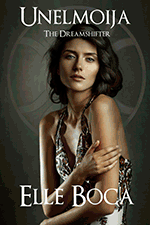by Editor | Jan 7, 2013 | Accomodations, Attractions, New Articles
Article and photos by Josette King

La Petite Venise was once home to tanners and fishmongers
Alsace, this strip of fertile plain stretched along the western bank of the Rhine River in the northeastern corner of France, is a region long on history and charm. The object of a millennium-long tug-of-war between France and Germany, it has successfully integrated elements of both cultures into a unique personality: decidedly French but with a noticeable German flavor in its architecture, arts, cuisine and traditions. And in spite of its troubled past, it has managed to preserve most of its cultural patrimony. Nowhere is that more evident than in Colmar, the medieval architecture gem in the heart of La Route des Vins, the much-visited hundred-mile country road that meanders north to south through the Alsatian vineyards.

Antique wrought iron signs are still a common sight in Colmar
Mainly spared the destruction of the French revolution and two world wars, Colmar has an exceptionally large and well-preserved historic center for a city its size (population 65,000). I appreciated its laidback small town joviality and its easily walkable cobblestone streets lined with architectural treasures that span eight centuries of combined French and German evolution. At the edge of the historic town, the especially picturesque La Petite Venise (Little Venice) neighborhood is clustered around a network of canals from the River Lauch, where tanners and fishmongers quarters were once located. Farmers also used these waterways to ferry their products to the town market in small pole-propelled wooden barges. Similar barges are in operation today, with silent electric motors, to allow visitors a close look at the ancient (and still inhabited) riverside homes.

Romantik Hotel Le Maréchal opened onto a private courtyard
One of the finest historic properties of La Petite Venise is the picture perfect Romatink Hotel Le Maréchal. The luxury hotel was created from four adjoining 16th century half-timbered houses with their steep tiled roofs and neat rows of windows underlined with flower boxes overflowing with red geraniums. The rear of the hotel abuts the edge of the river, while the façade opens onto a small private courtyard. Inside, common walls have been opened and passageways link the various common areas with a maze of cozy nooks filled with antiques. An elevator is discretely tucked in a remote corner. My room, located under the eaves at the very top of the property, had slanted beamed ceilings and dormer windows that overlooked the roofs of the old town.
With its rustic Alsatian décor (discretely enhanced by 21st century amenities) it was a charming nest that beautifully captured the romance of the historic city. Equally appealing L’Echevin Restaurant occupied the entire rear of the first floor. There the space had been cleverly distributed to form a long, intimate dining room lined with picture windows that overlooked the river. It provided a worthy setting for the excellent cuisine of Chef Thierry Chefdeville, who has officiated in the kitchen for over a decade, earning such coveted recognitions as two toques from Gault et Millau and three forks from Michelin along the way, and firmly establishing L’Echevin’s standing as a noted destination for Alsatian gastronomy.

The restaurant, L’Echevin, overlooked the river Lauch
The pleasure of my stay at Le Maréchal, along with a couple of superb dinners at L’Echevin and the opportunity to wander at leisure around neighborhoods of meticulously maintained medieval houses would be reason enough for a weekend break in Colmar, especially now that several daily TGVs (Train à Grande Vitesse) have made it an easy three-hour and twenty minutes ride from Paris. But on this recent visit, there was also the lure of the town’s foremost artistic treasure: the Unterlinden Museum. Housed in a 13th century Dominican Sisters’ convent that is in itself a fine example of Gothic conventional architecture, the Unterlinden Museum holds a rich collection of Upper-Rhenish medieval and early renaissance sculptures and paintings.
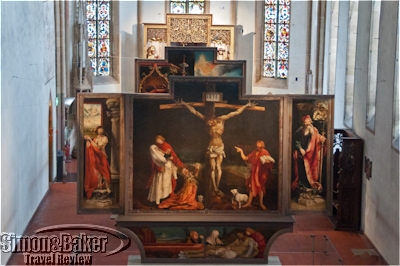
Matthias Grünewald’s masterpiece, the Isenheim Altarpiece is on display at the Unterlinden Museum
In addition to works by Lucas Cranach the Elder and Albrecht Dürer, it features several notable altarpieces by 15th century native son Martin Schongauer, and above all what is widely acknowledged as early 16th century master Matthias Grünewald’s greatest achievement: the Isenheim Altarpiece. Originally painted in 1512-1516 for the Monastery of Saint Anthony in Isenheim near Colmar, this unique oil on wood triptych has a center panel 2,70 meter (8 foot 10 inches) high by 3,10 meter (10 feet) wide depicting an especially poignant crucifixion scene. It was customary at the time for such triptychs to open to reveal additional scenes inside.
In the case of the Isenheim Altarpiece, there are actually two sets of wings, therefore two interiors. The first is a set of four panels depicting various scenes featuring the Virgin and Christ. The second interior is a carved shrine containing a polychrome sculpture of Saint Anthony flanked by Saints Augustine and Jerome, by sculptor Nicholas von Hagenau, with two more paintings (the Meeting of Saints Anthony and Paul, and the Torment of Saint Anthony) on the wings to the left and right respectively. In anticipation of its 500th anniversary, the masterpiece had been removed from view for restoration in recent years, and returned on display earlier this year.
by Editor | Nov 12, 2012 | Attractions
Article and photos by Elena del Valle

The unique exterior of the Soumaya Museum
During a recent trip to Mexico City, Mexico (see A weekend in Mexico City) I had an opportunity to visit the Museo Soumaya, one of the city’s fine arts museums and home of 400 Auguste Rodin and 60 Salvador Dali pieces among other fine arts works. The museum, named for a businessman’s deceased wife (said to have been an art lover and the inspiration for the collection), was the newer of two Soumaya museum buildings in the Mexican capital. Its 60,000 square feet of exhibit space housed ten percent (about six thousand items) of the extensive European and Mexican art collection of Mexican billionaire Carlos Slim Helu.

A section of a Diego Rivera Mural
Before entering the museum I was struck by the building’s exterior appearance, reminiscent to the Guggenheim Museum in Bilbao, Spain. Fernando Romero, Slim’s son in law, was the designer of the hourglass shaped building sandwiched between a mixed used building and shopping center and tall office towers. The light filled interior with a predominance of white was minimalistic and without windows.

The interior features suffused natural light
Attracting a mainly domestic audience, 70 percent, thanks to ongoing free admission, the museum had had a million visitors in the 14 months since its inauguration. For many Latin Americans, someone later shared with me, the museum provided access to the works of famed European artists such as El Greco, Van Gogh, Matisse, Degas and Picasso that they might not otherwise be able to see without a journey overseas.

Guide Alsacia Lorena Herrera Ojeda
Alsacia Lorena Herrera Ojeda, our well informed English speaking guide, first showed us The Thinker and a two-sided Diego Rivera mural she explained was originally commissioned for a pool area, in the museum entrance level. The seventh of twenty-four The Thinker sculptures by the famous French artist occupied a prominent place in the sparsely populated floor. The Rivera faced the bathroom en route to the museum’s gift shop and restaurant.

The Thinker
She then escorted us up a broad spiral staircase from the lobby to the top floor where we had a chance to view a number of Rodin and Dali sculptures. Rays of sunlight filtered down from the glass ceiling, illuminating the dozens of artworks on display. On the way down she stopped to shows us a few pieces and pointed to a handful of display walls with color. The museum was in the process of adding color to the exhibit space, she explained. The guided visit to the museum was a culturally rich way to spend tourist time in Mexico City. Museo Soumaya Fundacion Carlos Slim, Plaza Carso, Blvd. Miguel de Cervantes Saavedra 303 Col. Ampliación Granada, Miguel Hidalgo C.P.11529, México, D.F. , + 52 55 1103 9800, museosoumaya.org
by Editor | Oct 22, 2012 | Accomodations, Attractions, Restaurants and Food, Spas
Article and photos by Elena del Valle

The view from the rooftop of our Santa Fe hotel
It had been years since my last visit to Mexico City. After the immigration desk I made my way into the customs area where I first noticed the new airport building. I later discovered Terminal 2, spacious and new looking, was only several years old and said to already be struggling to accommodate traffic. After a few minutes my suitcase rolled out and I walked to the customs area where my luggage, check-in and carry-on, had to pass through an x-ray machine. Then I was asked to press a green button before I could continue. Depending on the response I might be subjected to further inspection, one of the customs staff explained.

From the rooftop of The Westin I watched the sunrise over Santa Fe
No further inspection was required although my wireless keyboard attracted the customs staff attention for some reason. As I exited the customs area I searched the crowd for someone with a sign. Fidencio, my driver that day, and an assistant greeted me warmly. From the airport to The Westin Santa Fe Mexico City (Av. Javier Barros Sierra # 540, Lomas de Santa Fe, Mexico City 01219 México, DF, +52 55 50 89 80 00, fax +52 55 50 89 80 58, www.westin.com/santafe, westin.santafe@westin.com), my hotel for the first night, the private transport took 90 minutes. As we drove I looked around and realized I hardly recognized the traffic jammed buzzing metropolis. From my tenth story 34 square meter Deluxe Room, on a Starwood Preferred Guest floor, I had a splendid view of Santa Fe, a recently built booming business neighborhood. The hotel itself had only been established in August 2010.

There were flower arrangements in the hotel common areas
Dinner with the group of four I was joining, wasn’t for several hours so I ordered a room service club sandwich with fries. Within minutes I was munching the hot and yummy comfort food and a few welcome sweets I found in my room to tide me over until dinner. From Santa Fe to the La Roma neighborhood multi-level home of Chef Monica Patiño where we were having a private dinner it was an hour’s drive, less on the drive back once the traffic had quieted down.

Griselda, my masseuse at Heavenly Spa
The following morning I rose early to catch the colorful sunrise view and work out at the hotel gym on the top floor before heading to the buffet breakfast at the ground floor restaurant. By 10:30 a.m. I was enjoying a good deep tissue massage with mini facial (not a favorite) courtesy of Griselda at the Heavenly Spa Westin, the hotel’s penthouse spa.

The exterior of the Soumaya Museum
By midday we checked out, leaving Santa Fe behind, making our way through heavy traffic for one hour to Museo Soumaya (Soumaya Museum), a 14-month old six-story structure housing fine art originals, mostly European and Mexican.
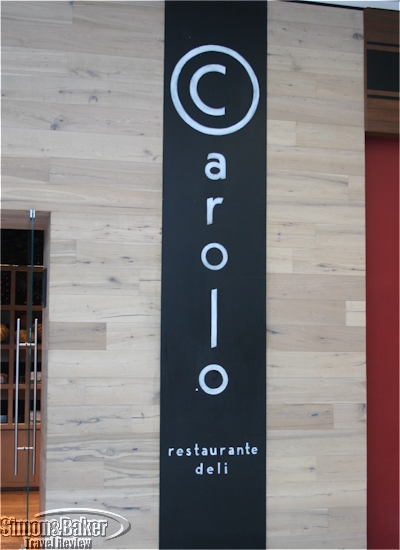
The entrance to Carolo Carso within a shopping mall and mixed use complex
From the museum we walked to Carolo Carso (Miguel de Cervantes Saavedra 303, Polanco, Mexico City, D.F., 11529, Mexico, +52 55 49 76 01 34, www.carolo.com.mx, info@carolo.com.mx), a Mediterranean style open air casual restaurant with an upper level view of the museum, within a large mixed use complex. It was one of several Carolo restaurants in the Mexican capital. Lunch consisted of a series of appetizer style dishes shared by the table occupants: Ensalada Chop (Chop Salad), Cuadritos de Atún (Tuna Squares), Mosaico de Salmones (Salmon Plate), Carpaccio de Res (Beef Carpaccio), Tacos de Rib Eye (Rib Eye Tacos), Tacos de Pato (Duck Tacos), Pizza Margarita (Margarita Pizza, a favorite), Risotto de Alcachofa (Artichoke Risotto, a favorite), Tostadas Orientales (Oriental Toasts), and Carmarones a los Tres Chiles (Shrimps in a Three Chili Sauce). Desserts too were set in the middle of the table for communal sharing: Pastel de Coco (Coconut Pie), Príncipe Alberto (Prince Albert Cake), Key Lime Pie, and Pastel de Tres Leches (Three Milks Cake).

Artichoke Risotto

Lunch at Carolo Carso

Marco de la O, executive chef, Carolo Group
At the end of the meal we had an opportunity to meet Marco de la O, executive chef, Carolo Group. A native of Puerto Vallarta, Jalisco he studied at the Universidad Anáhuac and at Panamericana de Hotelería in Mexico. De la O, who strives for excellence in quality, flavor and presentation, started his career at the Nikko Hotel in Mexico City. Later he worked at the Four Seasons in New York before returning to Mexico City.

The entrance of the Anthropology Museum
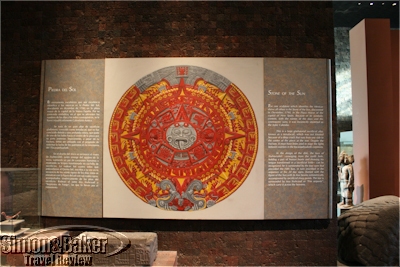
A representation of the Stone of the Sun at the Anthropology Museum
After lunch, we headed to the famous Anthropology Museum (Museo de Antropología) where Laura, a knowledgeable and patient guide escorted us to the Sala Maya (Maya Hall) for an outstanding, though brief because we arrived late, guided visit. A thirty minute drive saw us at the entrance of The St. Regis Mexico City hotel (Paseo de la Reforma 439 Colonia Cuauhtemoc Mexico City, Federal District 06500,Mexico, +52 55 52 28 18 18, fax +52 55 52 28 18 26, www.stregis.com/mexicocity, mexico.city@stregis.com) facing the Diana the Hunter (Diana La Cazadora) roundabout water fountain for check-in on the third floor of the tall building.
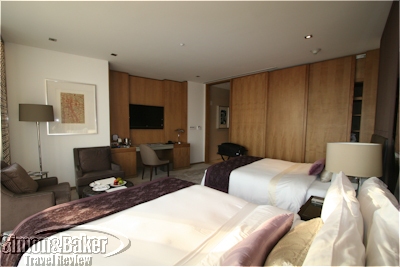
My room at The St. Regis Mexico City
The hotel’s spacious common areas were filled with sunlight, works of art and pretty flower arrangements. Friendly uniformed staff greeted us when we reached the lobby and escorted us to our respective accommodations following check-in procedures. The floor destination had to be selected on an outer panel with the electronic key card before entering the elevator, my staff escort explained.
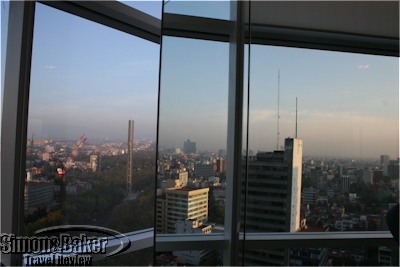
Mexico City seen from the St. Regis gym
Among my favorite features of the hotel were the lobby level views of the water fountain and the panoramic views of the city from the 15 floor work out rooms and adjacent pool area. From my twelfth story 50 square meter (538 square foot) Deluxe Room, on a Starwood Preferred Guest floor, I had a splendid view of Paseo de la Reforma and the surrounding neighborhood. Muted city sounds reached inside. Complimentary amenities on my floor were butler service, on demand 24-hour complimentary hot beverage service and the pressing of two items during my stay, my butler explained. The dimly lit room decorated in natural colors had thick double curtains to fend of the harsh sunlight, two double beds with thick plush mattresses and feather pillows, and a spacious marble bathroom with bathtub and separate shower, as well as a small remote controlled television screen built into the oversize mirror behind and between twin sinks. The new looking hotel dated to August 2009.

A black bean and foie gras appetizer at Dulce Patria
Dulce Patria restaurant (Anatole France 100, Col. Polanco, 11560, Mexico City, Mexico, +52 55 33 00 39 99, fax +52 55 33 00 39 95, www.dulcepatriamexico.com, kosberg@dulcepatriamexico.com), where we had a refined Mexican meal, was only twenty minutes from the St. Regis. Shortly after breakfast the following day we drove forty-five minutes across town to the Mercado de San Angel, a large covered odorous market filled with fruit and vegetable, fish, meat and a variety of other vendors.

Margarito Angeles Ramirez sold herbs at the market
Our first stop was at the stall of Margarito Angeles Ramirez who, after learning the skill from his grandmother, for 22 years had sold herb blends at the Mexico City market. A large mound of fragrant fresh herbs occupied the front of his stall which was chock full of items all the way to the rear wall and from the ceiling down. A variety of amulets, candles, dried herbs and plastic wrapped items took up most of the small space that was sandwiched between other market vendors down a narrow passageway. While we learned about his services, in Spanish, from Margarito several customers came by, squeezing through the tight space where we stood, to pick up their herb blends and orders.
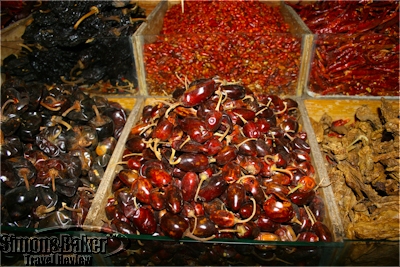
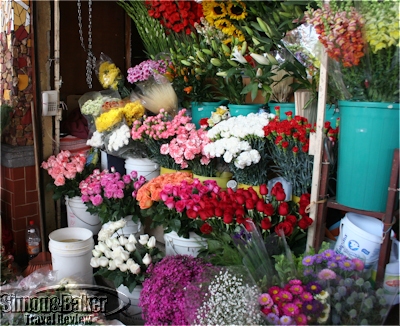
Vendor stalls at the Mercado de San Angel
With herbal blends, Angeles Ramirez said, he could, like a pharmacist, alleviate ailments such as allergies, migraines, headaches, indigestion and minor aches. He also provided mystical or magical white magic Santeria potions for good luck charms, attraction, and love. Prices ranged from five pesos to twenty thousand pesos. Some blends could be prepared while the customers waited while others required twenty days to be ready.

An unusual stop
From the market a short walk led us to the Public Baths (Baño Público), a fee based public steam and Turkish bath facility the owner kindly, if reluctantly, allowed us to visit. The San Jacinto Parrish (Parroquia de San Jacinto) was our next stop. Built atop an Indian temple the church, our guide explained, was important because it was at commercial crossroads of the 1500s. The church, as many others in the city, he said, had suffered severe damage in the early twentieth century although several original structures remained.
From the church we walked back a few blocks to the Saturday Bazaar (Bazaar del Sábado), a popular weekly indoor and outdoor arts and crafts market, where we spent the better part of an hour before heading to lunch at Azul Condesa, one of several Azul restaurants headed by Chef Ricardo Muñoz Zurita, in the Condesa neighborhood.


Favorite dishes at Azul Condesa
At lunch, we sat in an open air interior courtyard. Every table was full and the volume was so loud I could only hear my immediate neighbors at the table. Appetizers included several Yucatan dishes: Sope de Cochinita Pibil, a bite size morsel of succulent shredded pork topped with red onions that had been marinated in Yucatan bitter orange atop a sope, corn made bread cooked on a skillet; Sope de Hongos, a mushroom topped sope; and Salpicón de Venado, a European venison morsel made with onion, tomato, spicy chilies served with avocado and tortilla chips. My favorite was the Sope de Cochinita Pibil.
For starter I ordered the creamy Cream of Cilantro Soup served with toasted almonds, one of few non hot items on the menu. I sampled my neighbor’s juicy Duck Confit served with a red berry and plum sauce (a favorite) and my own dish, Roasted Skirt Steak served with home fries. From the dessert menu the server recommended Soursop Foam with a red berry sauce. Chili candies were served with coffee at the end of the meal.
by Editor | Oct 8, 2012 | Attractions
Article and photos by Elena del Valle

Saint Pere sous Vezelay
While I was in Burgundy I had a chance to see the well known hilltop town of Vezelay and nearby the village of Saint Pere sous Vezelay. My local guide explained that Vezelay was a popular tourist town. We were fortunate. It was only raining lightly that day. Because of the constant rain in the past few days streets, shops and attractions were empty or near empty, allowing us to enjoy the town at our leisure.

The Vezelay Basilica
In Vezelay, we parked the car in the designated metered parking area and walked up a narrow street to the church and lookout area a the top. On our way, we stopped at the Musée Zervos Maison Romain Rolland, a restored home and exhibit space for the work of Christian Zervos, a publisher and art critic, and Romain Rolland, a political writer. The museum had been recommended by one of the owners of the hotel where I was staying. As we continued we glimpsed the exterior of city hall and browsed at several shop windows along the way.

A restored building in Vezelay
By the time we reached the top fortunately there was a break in the rain. We were the only ones at the viewpoint. The view of the valley and the village of Saint Pere was memorable. From there we visited the adjacent Basilica of Vezelay.

There were temptations along the way
While in town, we made time for tea and a pastry at a cafe and shop that sold Asian artifacts and offered guest accommodations; we stopped at a wine and regional products shop and at Atelier Marie Noelle, a small shop selling locally manufactured silk and wool products (69 rue Saint Pierre, 89450 Vezelay, +33 03 86 33 26 02).

The facade of Atelier Marie-Noelle
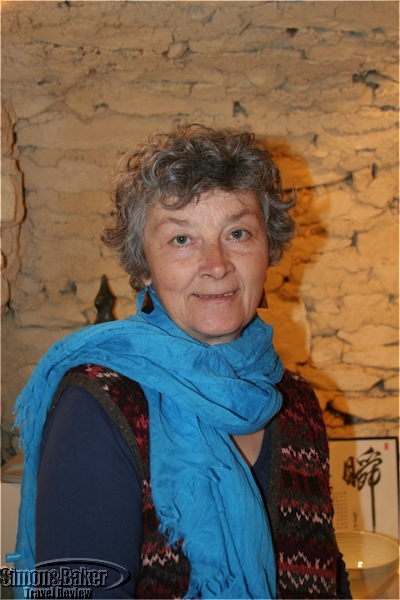
The ceramic shop owner showed us around her exhibit space
In Saint Pere sous Vezelay, we walked along the streets near our hotel, Domaine de L’Espérance Marc Meneau (see Boutique Burgundy hotel offered elegant accommodations, gourmet meals, area tours). Along our way we saw a bakery and the outside of the village church. At Poterie de Saint Pere (2, ruelle de l’eglise, 89450, St.-Pere-sous Vezelay, +33 03 86 33 35 07, www.poterie-st-pere.com), a ceramic atelier and showroom near the church, we met the owner Sylvie Wlotkowski who kindly showed us her handmade functional pottery and ikebana work. We had hopes of visiting the town’s wood workshop, said to be extraordinary, but a friendly neighbor informed us the owner was out of town.
by Editor | Aug 20, 2012 | Attractions, Ecotourism
Photos by Gary Cox
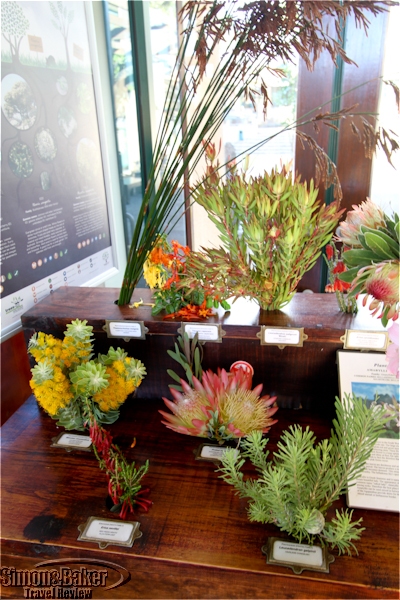
Seasonal plant displays in the entrance hall
When our contributors visited Cape Town earlier this year they spent a morning at the Kirstenbosch National Botanical Garden

A clear view of the cape flats
Although they were caught by a downpour before they could complete their explorations they had much positive feedback. Click here to read about their visit to the 538-hectare estate with a 36-hectare garden that will celebrate its centenary anniversary next year.
by Editor | Aug 13, 2012 | Attractions
By Elena del Valle
Photos by Gary Cox

The entrance to The Big Hole exhibit
Miles and miles from the country’s urban centers and famous attractions it seemed, at first glance, that Kimberley, the capital of the Northern Cape, one of the provinces of South Africa, had little to offer tourists. Since the big mine closed even local youth were departing as soon as they could never to return, we heard from a local distressed by the population flight. A closer look revealed that since 1888 Kimberley has been home to De Beers Consolidated Mines (DBCM), South Africa’s largest rough diamond producer, and the Big Hole, a world renowned diamond mine.
Although the mine was no longer active when we visited the area, according to locals and the De Beers websites the company owns the land and helps manage The Big Hole tourist attraction designed to replace some of the revenue lost following the closure of the Kimberley mine. As diamond and history aficionados riding the Rovos Rail train between Pretoria and Cape Town we found a visit to town to see new facilities of The Big Hole appealing. During our three hour stop in Kimberley the train company organized a guided visit for interested passengers to The Big Hole attraction, a museum and display center of the days of glory of Kimberley, offering us an opportunity to see the exterior of the famous Big Hole and learn about its origins and history.

Veronica Bruce told us about the history of the mine
Our excursion began at 9:45 a.m. and ended at 12:30 p.m. on a Saturday in the summer. Veronica Bruce, our knowledgeable and courteous local tour guide, met us at the train station platform. She invited us to pick up a bottle of water from a cooler before boarding a large bus. During the short drive from the station to The Big Hole she described a little of the history of the area and the attraction we were about to visit.
There were several activities on offer at The Big Hole including Underground Mine Experience, Real Diamond Display in a vault (such as the 616, the largest uncut octahedron diamond in the world, and The Eureka), Viewing Platform, Pulsator Building, Diamond & Destiny Film, and Old Mining Town with restored period buildings. The guided tour allowed us to see several of them and maximize our limited time there.

The Big Hole is full of water
To enter we had to pass a hand held metal detector inspection. Once inside the new looking cavernous building with a towering ceiling our tour guide led us to a mini theater where we watched a brief video dramatization reenacting the history of the city with the aid of fictional characters (a travel journalist and a tribesman). We learned that in 1866, Erasmus Jacobs, a 15-year-old playing on the banks of the Orange River, near Hopetown and about 30 miles from present day Kimberley, found the first diamond in the country, a 21.25 carat diamond in the rough his mother gave away thinking it was a worthless rock. It was later named The Eureka.
Following the film we walked onto a cantilevered walkway, 30 Cape feet wide and 30 Cape feet long and the size of a 19 century mining claim, to see the Kimberley Big Hole from above. From our height, well above and to the side of the hole, we saw blue green water filling a very large opening in the African soil; over time rain water had replaced the dirt removed during decades of mining. It was a blistering hot morning, especially atop the unshaded walkway under the punishing rays of the mid morning sun. Although we didn’t want to linger we were mesmerized by the sight of the water filled hole.

A replica of the Star of South Africa
After listening to her descriptions of the history of the Hole (unofficially diamonds were first found in what would eventually become the Hole by a cook, she explained) we walked down one floor into the old mine now converted into a tourist display with sound effects and lights to showcase for visitors what conditions were like in the old tunnels. There was an elevator with capacity for less than half of our group so most of us took the stairs. Inside the corridor of the former mine she showed us old mining tools and explained the dynamite and mining process used when the mine was first established.

A replica of the Dresden Green
On resurfacing from the underground section we walked to the diamond exhibit in a vault that featured examples of stones and their regions of origin and resin replicas of some of the famed diamonds (a couple of the authentic stones were on loan). Next we saw some of the exhibits that illustrated the diamond mine city’s history. Our guide had allotted 30 minutes of free time for those travelers from our group wishing to visit the attraction curios and diamond and jewelry shops within the complex before the bus departed back to the train station and our onward journey toward the Western Cape.

A replica of the Hope Diamond
Serious shoppers would have to rush because there were only two or three small diamond and jewelry and other curio shops and 34 passengers on the train in addition to regular visitors to The Big Hole. The diamond and jewelry shops sold ready made jewelry and loose diamonds. Surprisingly, top quality diamonds were only available in one carat and larger sizes, a sales lady explained in the shop we visited briefly.
Once again there were cold beverages on offer before we boarded the bus for the short drive back to our train. When we arrived at the station Rovos Rail staff awaited us with refresher face cloths and sparkling wine. Soon we were back aboard the train preparing for lunch and reminiscing about the history, the mine and the famous diamonds sourced in Kimberley.














































